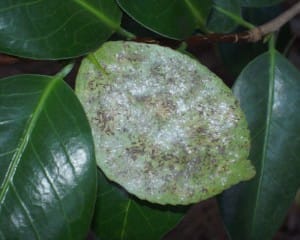Source(s): Patricia Cobb, Extension Entomologist, Alabama Cooporative Extension Service, Auburn University.
Tea scale is serious pest of camellias and certain other ornamental plants in Georgia. Scale insects pierce plant tissues and suck out juices which reduces the vitality of the plants. Heavy infestations result in unsightly plants, fewer and smaller blooms, twig dieback and possible plant death.

Tea scale is one of the most widely distributed and most damaging insect pest on camellias. Tea scale infestations are also quite common on large-leafed hollies. Tea scales feed underneath leaves. This usually causes the upper leaf surface to become yellow-splotched. When infestations are heavy, cottony filaments can be seen hanging from the leaves.
Identification:
A waxy covering develops over each scale as it grows. The females develop hard brown covers about 1/10 inch long. The males develop fragile white covers that are usually a little smaller than those of the females. Females lay eggs for several weeks and eggs hatch continuously. This results in overlapping generations almost year-round.
Control:
A major problem with tea scale control is that often damage has been done before the scale infestation is noticed. This means that in spite of control efforts, the damaged leaves will often be retained by the plant for at least a season or more. A 2- or 3-year program may be necessary to bring the infestation to a manageable level.
Beginning in April, use acephate (Orthene), carbaryl (Sevin), malathion, imidacloprid or other recommended insecticides according to label directions to control tea scale insects. Fall treatment may also be needed if infestations are heavy. Add a spreader-sticker to your spray mixture and be sure to direct the spray to the underside of leaves to obtain better contact of the insecticide with the scale insects.
Insecticidal oils may be effective in control of light to moderate tea scale infestations. Some oils can be used in the spring prior to or after blooming and in the fall prior to blooming. Highly purified oils such as SunSpray can be used during the growing season. Check the label for use instructions.
Resource(s):
Insect Pests of Ornamental Plants
Center Publication Number: 122